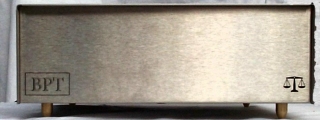Product Review -
Balanced Power Technologies BP-2 AC Line Conditioner - September, 2001
John Kotches
![]()
|
|
Model BP-2, Ultra Edition Fully Balanced AC Power Line Conditioner 8 Outlets Maximum Output: 17.5 Amperes Dimensions: 5" H x 12" W x 12" D Weight: 40 Pounds MSRP: US$599, + US$200
for Ultra Edition |
|
Balanced Power Transformers, Inc., Phone 314-603-1483; E-Mail [email protected]; Web http://www.b-p-t.com |
Introduction
Several months ago, I am loathe to admit, I was running without any kind of power conditioning whatsoever. In my old home, with old wiring, I didn't really feel the need for any power conditioning because hey, my system sounded pretty good.
Then I started getting transformer mechanical hum from one of my amplifiers, and I simply could not get rid of it. I was discussing this problem with JJ and Stacey to try to isolate the cause. At that point, JJ decided to send me the Equi=Tech 2Q product to see if that might resolve the issue. In the span of a single weekend, I became a power conditioning convert. No more transformer hum, and without changing volume, my system seemed louder.
The time came to send the Equi=Tech back, as it was more expensive than I could afford, and a posting on one of the Internet forums led me to the company whose product is under review.
Balanced Power Transformers is headed up by Chris Hoff, and I purchased this unit untested, which is the norm for a company that sells factory direct. Not everyone is comfortable making these types of purchases, and I can understand the hesitation. The good news is that most factory direct companies offer a money back trial period. If you aren't satisfied with the product, you have a certain number of days in which to return it. In BPTs case, you have 30 days to make your decision, and you may return for full credit anytime within that 30 days. In that case, you are out shipping to and from the factory, and that's it. I consider this a fair and reasonable cost for the privilege of an extended in-home audition.
BPT's goal is to deliver a quality balanced power unit at a more reasonable cost than their competitors. By eschewing some of the bells and whistles, they are able to come in at their (relatively) modest price.
Balanced Power Means 60V + 60V = 120V
You've read about various and sundry balanced power solutions in Secrets for some time, and the results of our DVD benchmarks bear objective evidence that some power solutions can make measurable (and audible and visible differences) within our A/V systems. The concept of balanced power is considered by some to be a tweak. However, for countries using 240V power delivery (much of Europe for example), they're already receiving balanced power.
The US National Electric Code now recommends that Audio/Video systems be connected to balanced power systems, lending further credence to our objective results that using balanced power wherever possible is a substantial improvement for your entire system.
Here's my read of balanced power, and you can compare it with JJ's and Stacey's explanations in other Secrets reviews.
In the United States, our power standard is 120V from the wall. Most electronics are wired with 3 prong outlets, labeled Hot, Neutral and Ground. The normal (which could correctly be referred to as single-ended) delivery method provides 120V potential between the Hot and Ground lines, and 0V potential between the Neutral and Ground lines. That is what it's supposed to be. Unfortunately, since everyone in the neighborhood is on your power grid, we end up with significant voltage between neutral and ground.
Balanced power delivers +60V between Hot and Ground and -60V between neutral and ground. This gives a total potential of 60V + 60V, or 120V, the same as your component is expecting. The positive benefit is that most power line noise is common between the two lines, and will get cancelled when summing the two circuits together (called Common Mode Rejection) or CMR).
A differential (a.k.a. balanced) circuit topology in an audio component (if it's truly balanced) will also get the same noise reduction benefits (again, called CMR).
The Ultra Edition I purchased includes BPT's CA-7 power cord instead of their usual CA-10 power cord, along with upgraded capacitors, chassis damping, hospital grade outlets, and the Stainless Steel (vs. powder coated steel on the standard edition). You'll have to decide for yourself if you consider the Ultra Edition worth the extra $200, but that is what I purchased.
What's underneath the hood?
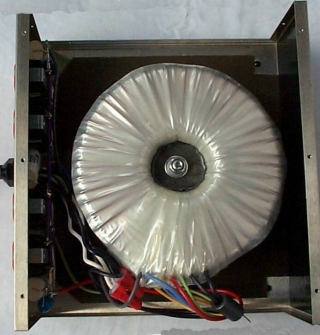
The heart of this product is front and center, a 2 kVA (2,000 watts) balanced power transformer. The connections off the transformer are fed to each of the four sets of hospital grade duplex outlets. This is where almost the entire weight of the BP-2 is concentrated.
Here's a shot of the backside of the "business end", and you can see the wiring to the outlets, along with the various capacitors used within the BP-2. The capacitors help filter out high frequency noise (RF).
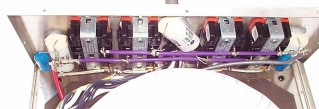
Finally, we get to the power outlets. These are hospital grade, and you have to exert a bit of force to insert your power cords into them. You also have to give a solid tug to remove them, which means your power cord probably won't get pulled out accidentally. Yes, in the snarled mess behind my system, I've had that happen.
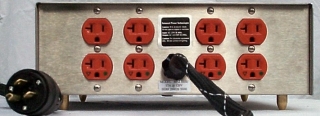
BPTs CA-7 power cable is hard wired (non-detachable), and it's silver plated copper, with Teflon dielectric. It's nicely made, and unlike most audiophile water hoses (I mean power cables), it is flexible. You can work it around the rack easily for organizing that snarl of cables. For vibration isolation from your rack (or wherever the transformer resides), brass footers are used. They're barely visible beneath the unit in this picture.
Internal vibration control (on the Signature and Ultra editions) is accomplished by the damping material pictured here, which is a rubbery pad attached to the inside top of the case.
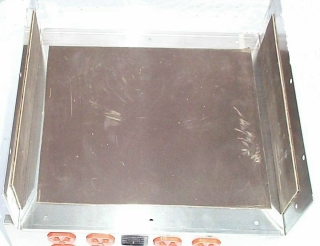
This leads me to the one area that I feel could be slightly improved, the fit and finish.
I think that the chassis could be a little stronger than it is, and I thought the cover was less than a perfect fit. I had to plug the power cord into the outlets to align the cover and the screw holes inside the chassis to reattach the cover. Once reinstalled though, you'd never know it was a mild adventure to get it all reconnected, and it is unlikely a consumer would have to open the case in the first place.
So, what doesn't this product have that its more expensive competitors do? Obviously some features have to give to deliver the BP-2 at this price. Voltage regulation isn't included, so you get ostensibly what is put in, but balanced. This isn't quite true, as there seems to be a slightly greater than 1:1 turns ratio between primary and secondary. When I measured voltage from my wall, it was at 122.4V. When measuring the output of the BP-2, I came up with 63.3V on both hot-ground and neutral-ground. This indicates a 1.034:1 turn ratio from secondary to primary taps. You get a little more voltage, and a little less current. There is no on/off switch, and there are no delayed turn-ons for components attached to the BP-2. BPT make no secret that this is a basic product, designed to do one thing well, namely provide balanced power to your audio/video system.
Also, neither this product (nor ANY of its competitors) can be 100% efficient. To do so would violate the 2nd Law of Thermodynamics, paraphrased as "There is a price for all actions". The maximum draw on the circuit is 20A, and the maximum output is 17.5A, indicating a loss of 2.5A or 87.5% efficiency. Not exactly chopped liver. The power that isn't used for output ends up getting dissipated as heat, and indeed the case of the BP-2 gets slightly warm to the touch.
What it does for my system
At the present time, I don't have the luxury of a perfect electrical environment for my listening room. In fact, it's probably like most of our reader's rooms. I have presently a single 20A circuit which so far has sufficed to this point. At various times I have multiple high power amplifiers, and to this point I had not tripped my circuit breaker.
When my BP-2 arrived, I did what any self-respecting audio journalist would do. I immediately plugged it into the wall, and lost power to the room. I tripped the breaker. So, grudgingly I picked up the instruction sheet that comes with the BP-2 and read the simple directions. When you go to plug this in, turn everything else on the circuit breaker off. There's a massive inrush of current when the BP-2 is plugged into the wall ("Look Ma, no switch"), and if other items are powered on, you will likely trip the breaker. Learn from my experience if you purchase one! After the usual grumbling of having to go down to the basement to cycle the breaker, I got started again, and all was dandy. As an aside, the more expensive Equi=Tech has developed a way of avoiding this problem.
The effects of balanced power were to my ears easily detected. At any given volume level, the system sounds "louder" subjectively. Because the noise floor of your components is lowered (from the Common Mode Rejection of the balanced power transformer), you will perceive your system as louder even though the SPL meter isn't lying when it continues to blare the same 87dB at you.
The other noticeable effect is that none of my system's power transformers gave out a mechanical hum that was audible without literally putting my ear onto the chassis to hear the hum. Before using the BP-2, I could induce transformer hum and buzzing by simply turning on a halogen lamp on the same circuit as the power amplifiers. After installing the BP-2, with the halogen on low, a nasty buzz is emitted from the BP-2s transformers, yet all connected equipment remains blissfully silent, as if in testament to the ability of balanced power to remove the evil noise! By turning up the halogen to full, the buzz is gone from the BP-2s transformer.
In case you think the transformer hum is subjective, I measured the hum from one amplifier plugged straight into the wall, without the BP-2 attached, and got 63 dB at 1 foot. With the BP-2 powering the amplifier, the hum was not measurable with the Radio Shack meter, and undetectable by my ears without putting my ear to the amplifier chassis. This would indicate an attenuation in excess of 30 dB if my estimate is correct.
I was unable to connect my TV set to the BP-2 (too far from the unit), so I don't know what effects it would bring to display devices. Also, note that you are not supposed to use lighting equipment with balanced transformers. This is electrical code, not anything from BPT.
Conclusion
Balanced Power Technologies delivers tremendous bang for your power conditioning buck with the BP-2. In my system, it delivers most of the performance of its competitors at a small fraction of the price.
In an industry rife with sketchy science from some products, and particulate matters of mystical qualities from others, we have here a product which is based on a foundation of proven science. Inclusion of balanced power into the US' National Electrical Code lends credence to the validity of balanced power within your Audio/Video system.
If you want to investigate what Balanced Power can do for your system, and if you don't have the budget to investigate the balanced power offerings from BPTs more expensive competitors, give this product a look. You can always get your money back if you aren't satisfied.
- John Kotches -
![]()
© Copyright 2001 Secrets of Home Theater & High Fidelity
Return to Table of Contents for this Issue.

